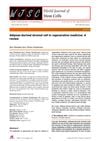TLDR Store stem cells at 4°C in 10% human serum and use within 2-4 hours for best results.
The study investigated the optimal conditions for short-term storage of human adipose-derived stem cells (ADSCs) to maintain their viability for clinical use. It found that storing ADSCs at 4°C in 10% human serum (HS) was the most effective method, providing the highest survival rate and avoiding the need for cryoprotectants, which can cause toxicity. This method outperformed storage in 10% platelet-rich plasma (PRP) and 0.9% NaCl. The study emphasized that ADSCs should be used within 2 to 4 hours of storage to ensure their functionality, highlighting the importance of standardizing ADSC preparation and storage for clinical applications.
 316 citations
,
June 2017 in “Stem Cell Research & Therapy”
316 citations
,
June 2017 in “Stem Cell Research & Therapy” Fat tissue-derived cells show promise for repairing body tissues, but more research and regulation are needed for safe use.
 15 citations
,
June 2015 in “Human Cell”
15 citations
,
June 2015 in “Human Cell” Spheroid culture in agarose dishes improves survival and nerve cell growth in thawed human fat-derived stem cells.
 81 citations
,
December 2009 in “Journal of Dermatological Science”
81 citations
,
December 2009 in “Journal of Dermatological Science” Fat tissue stem cells may help increase hair growth.
 76 citations
,
January 2017 in “World Journal of Stem Cells”
76 citations
,
January 2017 in “World Journal of Stem Cells” Fat tissue cells are a promising option for healing various diseases, but more research is needed to ensure they are safe and effective.
May 2021 in “F1000Research” The treatment led to denser, thicker hair growth and less hair loss.
January 2021 in “Faculty of 1000 Research Ltd” The treatment showed promising hair growth results but needs more research.
January 2021 in “Faculty of 1000 Research Ltd” Combining SVF cells with PRP may boost hair growth in androgenic alopecia.
29 citations
,
December 2021 in “Biomedicines” Exosomes from different stem cell sources affect immune cells and brain cell growth differently.



